
Wine Culture and Information since 2002 - Volume 22
 Wine Culture and Information since 2002 - Volume 22 |
|
Issue 98, Summer 2011 |
Contents |
|
|
Italy Versus France. Again. |
|
Italians can finally rejoice at a remarkable result which will change the fate of our Country and will make all wine producers happy and full of proud. Even more beautiful and taller. It is now official: Italy makes more wine than France! An incredible news, the news of the century, of course, just like the news of every vintage that, year after year, are announced as the one of the century. Let's be serious now. We make more wine than France. So what? What do they want to prove with that? What is the merit we can get from this? What is the contribution to the viticulture and enology of the Country, in the most significant term, that is quality? Pardon me for being ironic, but, frankly speaking - and, once again - I cannot really understand the importance of such a news. Making more wine than someone else really means being better or making a better wine? I have doubts about this, in particular, I don't understand this supposed merit if we compare the result with the other important figures of the world of wine making. The news has been spread by OIV, Organisation Internationale de la Vigne et du Vin (International Organization of Vine and Wine) and in Italy, the news has been spread by many, from newspapers to TV. Many have “forgotten” to spread the news in its complete form, by omitting, for example, some significant figures, very useful in order to fully understand the sense of the news, simply concentrating on the least important figure, that is quantity. According to this news, in 2010 Italy has produced 49.6 millions of hectoliters of wine, whereas France has “just” produced 46.2. A difference, in favor of Italy, of 3.4 millions of hectoliters. According to this result, in 2010, Italy is the first wine producer of the world, we are the country making the highest quantity of wine in the world. Quantity, this is the point. What do the other figures say? Those figures making a real difference for the prestige and economy of wineries? If we consider the importance of this news - not so important anyway, when there is no relation to quality - by considering the other figures, the meaning of the result seems to be quite different. According to the figures spread by OIV, in 2010 Italians have consumed 24.5 millions of hectoliters of wine, whereas the French did it better by consuming 29.4 millions of hectoliters. Therefore, the French have drunk almost more than five millions of hectoliters of wine than Italians. How comes, in Italy it is being produced more wine than France, although they consume a lesser quantity? Some could say Italy exports more wine, therefore this could explain the higher quantity produced in this country. True: Italy has exported 20.1 millions of hectoliters of wine, whereas France has exported 13.5 millions of hectoliters only. A positive figure, we could certainly say: Italy has exported 6.6 millions of hectoliters more than France, a quite significant result. In recent years, the export of Italian wine, in particular to the United States of America, has continuously grown up, probably winning the race against France. In other words, in the United States, when they decide to uncork a bottle of foreign wine, their preference is most of the times for Italian wine. The quality of Italian wine - this is undeniable - improved very much in recent years, something which has certainly been appreciated outside our Country, in particular when compared to French wines. If we consider this important result with the last figure spread by OIV - the one concerning the value of export - this result must necessarily be considered quite differently. The value of export for Italy is equal to 3.9 billions of euros, whereas France, although they exported about seven millions hectoliters less, has cashed 6.3 billions of euros. This value highlights two very important factors. The first one is that, in the other countries, Italian wine is cheaper than French wine, a factor which probably invites, in particular in these not truly prosperous times, to uncork a cheaper wine. The second one, and probably the most significant one, is that profit margin for Italian wineries exporting wine is lower than the one of French cousins. Italy exports and makes more wine, but makes a lot less money than France. This however brings to an important consideration: can it be Italian producers are forced to “undersell” their wines, probably because they make a lot of it, in order to avoid a dangerous accumulation and having the risk, not so light, to not sell the wine at all? In other words, it is better to sell a wine at a low price instead of not selling it at all or to sell it to distilleries, which is almost like not selling it. Maybe, could it be the French, once again, have understood that you can make a lot of money from wine, while producing a lesser quantity? If we consider the result of being the first wine producer of the world according to this aspect, it is evident it looks like a Pyrrhic victory. The consumption in Italy is going down, but they make more wine. The wine exported from Italy is going up, but the profit margin is not so high. Nevertheless, the French consume more wine than Italians and they make less, they export less wine and make more money. Making “more” is therefore better? It probably is not the case. Why are the French successful is making more money while exporting less? The answer could be banal: the quality of exported French wine is higher than the quality of Italian wine and therefore it has a higher value. Italy exports quality wine, but also - and maybe in higher quantity - ordinary wine, therefore if you want to sell it, you have to sacrifice your profit margin. Quality has a price, no doubt about this. And in the glass you need facts, not just words or supposed merits. Italy is the first wine producer of the world, but it also makes less money from it. And I cannot still understand the reason why we should be happy for a news like this. Antonello Biancalana
|
||||
Moelleux: the Soft Roundness of WineFor many it is the gustatory sensation typical in great wines, for others it is the distinctive mark of standardized and predictable wines, in perfect international style |
|
For many years, round wines - with that thick and rich roundness, almost mellow with a vague sugary taste - have been declaimed and praised by every wine guide and by most of wine lovers. For years, these wines, have undoubtedly been the enological reference all over the world, they suddenly became the protagonist of every glass, copied by many, both in their good quality as well as in bad ones. Last but not the least, this kind of wines has strongly influenced wine marketing, while trying to satisfy the taste and the increasing requests of consumers, in order to ensure higher profits. In case a wine was not “round”, it did not have the consent of the mass, at worst, it was a wine which was poured in the glasses of those who were looking for different sensorial emotions. It is a matter of taste, of course, however, sometimes the excess of roundness can make a wine unbalanced and not very interesting, with no surprises, however reassuring. For a long time, wines capable of expressing a certain elegance - a concept that, it should be said, is quite subjective - from the harmony of aromas to gustatory balance, seemed not to have the consent of wine lovers anymore. For a long time, they tried to look for the reassuring embrace of round smells, in particular the ones obtained from the aging and fermentation in barrique, very direct and standardized, in order make them taste like countless other wines. Also in the mouth things were not so different: the “simplicity” of a round wine, with no complications, most of the times with a robust body, almost huge, kept at a distance - sometimes even suffocating them completely - both acidity and astringency of tannins. In this gustatory picture, also alcohol found a greater expression - element that, we should not forget, significantly contributes to the sensation of roundness - with the effect of obtaining more alcoholic wines. These wines, with a strong round character, so round as to recall, in certain cases, a slightly sweet sensation, and that in some cases sweetness is really present because of a small quantity of residual sugar, have contributed to the equalization of organoleptic qualities in wines. Or, like to say, they contributed to the standardization of expectations consumers had towards every wine. As gustatory balance in wine is a fundamental factor for the definition of quality, by having pandered - although we should better say, influenced and controlled - the taste of consumers, this was the origin of real efforts of equilibrium both in vineyard as in wine making, in order to get roundness, concentration and power. It is then happened that, in case they wanted to be successful in marketing, grapes which have always made light but elegant wines - last but not the least - balanced, have been forced to go to the gymnasium and to build up strong muscles. Everything started, undoubtedly, from Merlot and barrique. Some tens of years ago, when worldwide wine quality was about to start its journey, every wine made from Merlot fermented or aged in barrique was successful, getting the full appreciation from wine critics, therefore the appreciation of consumers. Everything started when emerging wine making countries - in particular the United States of America - have tried to make wines by imitating the French style. They believed the secret of the French was Merlot and barrique - at those times, Bordeaux wines were the most common and appreciated ones - and therefore they tried to make wines by mainly using these two elements. This brought to the exaggeration of the model and to technological exasperation, a model which ended up to be considered as a reference, also because part of wine critics supported it, in particular American ones. France and other historical wine making countries, were, like to say, forced to follow and obey this new trend.
According to an organoleptic point of view, a round wine is more immediate and direct than a wine having a more complex gustatory profile, where also astringency and acidity compete in the overall balance. There are many who support the idea this style of wine is successful because it recalls infantile gustatory sensations, therefore simple and reassuring. There are many who support this style of wine is usually preferred by beginner wine lovers, as its personality can give immediate and simple “organoleptic satisfactions” anyone can recognize. Both ideas are plausible: it is not by chance as one grows up in the personal sensorial tasting journey, one usually tends to like wines with a character distant from roundness, while looking for stronger qualities such as acidity, while however having elegance and, last but not the least, balance. This can be explained by the relation “expert” tasters have with wine. They do have little satisfaction in recognizing or discovering the sensations perceived from the glass; indeed, they try to analyze the wine while trying to perceive the least evident nuances, less immediate, the ones giving a wine character and personality. It should be said searching for nuances in a wine is getting more and more complex and difficult, also because of the undeniable technological equalization introduced both in vineyard and in wine making. The use of technology and tools available to anyone, has contributed to the spreading of a sensorial model virtually repeatable and usable everywhere. A good example is the use of selected yeast - giving the wine specific aromatic qualities, most of the times covering the character of grapes - as well as the use of cask and barrique, capable of giving the wine specific tannins and organoleptic, aromatic and gustatory elements, recognizable in thousands of wines. The race for roundness has also brought to the progressive increasing of alcohol in wines. Some tens of years ago, and this is was also the case of France, a wine with an alcohol by volume higher than 13% was considered an exception: the average volume generally was of 12.5%. The increasing of roundness in a wine requires a proper increasing of a contrasting element, in order to get balance. Roundness is generally balanced by acidity and astringency, although as roundness in grapes is also obtained with ripeness - a condition determining the decreasing of acidity - one must add tannins during the fermentation or aging process by using casks of strong impact, such as barrique. Moreover, in some grapes - such as Merlot - naturally characterized by a modest quantity of acidity and a good quantity of “round” elements, the aging in barrique seems to be almost mandatory. Roundness can also be obtained by using ripe grapes, a condition increasing the quantity of sugar, therefore - at the end of primary fermentation - it is produced a higher quantity of alcohol. Among the many roles played in the gustatory profile, alcohol contributes to increase the round character of a wine, therefore affecting balance. In other words, it is an endless race, as the increasing of an element requires a proper increase of one or more contrasting elements, in order to get balance. Also the production of extreme concentration, in order to make wines of deep colors and robust structures, even from the grapes generally having a low quantity of “solid” material, requires the exaltation of certain organoleptic characters or their correction in quantity. It is no secret that, when needed - or in order to get a specific result - during the wine making process it is possible to correct a wine by adding, legally, tartaric acid or glycerin, for example. Two important figures of the world of wine in the 1900s, ╔mile Peynaud and Jules Chauvet, besides setting the fundamental elements and development of modern wine making, have also defined the principles of modern sensorial wine tasting, by suggesting a method based on a scientific model, by explaining, among the other things, the concept of “roundness”. Concerning this aspect, we should also remember Jules Chauvet, besides having been a wine maker, expert chemist and wine taster of rare talent, more than any other else, he studied the importance of the tasting glass. His studies and researches allowed him to define the shape and dimension of the famous INAO glass, today commonly known as standard ISO tasting glass. In their books about sensorial wine tasting, both Peynaud and Chauvet used the term moelleux - a term now widely used in the world of wine - in order to define this kind of round wines. The term has however been cause of confusion, in particular because of the translation in other languages - in particular English - by giving this word, erroneously, the meaning of sweet, therefore associating the word to the presence of sugar. The term moelleux is used in France to specify a category of wine style, wines characterized by a medium sweetness, however when the term is used in sensorial wine tasting, it gets a quite different meaning. The term moelleux is defined in the famous French dictionary Larousse as «something being soft and elastic to the touch. Something having a round and velvety taste, sound or aspect, when referred to meat, it means tender meat. It is also said of a round and bodied wine». Larousse dictionary also informs us the etymology of moelleux comes from Latin medullosus, that is, “like marrow”, that is full of marrow, such as bones. In other words, when we talk about sensorial wine tasting, sweetness and sugar has nothing to do with the term moelleux. It is therefore defined as moelleux a wine having in the mouth a round, soft, smooth and velvety character. For the French, the moelleux character is fundamental for the balance of a wine, as it is the factor capable of balancing both acidity in white and red wines, as well as astringency of tannins in red wines. This recalls the concept of balance in wines - used still today in sensorial tasting - a concept which was defined by ╔mile Peynaud and Jules Chauvet. What is moelleux character in wines made of? All the qualities in which taste directly recall roundness and, then, a mildly sweet taste. Among the main components we find ethyl alcohol and the so called polyalcohols, such as glycerin. Alcohol, besides producing the well known burning effect, it basically has a slightly sweet taste and produces a tactile sensation recalling roundness. The sensation of roundness is also accentuated by other substances generally found in grapes - and therefore in the must - such as pectin, mucilage and gums. Among the other factors contributing to the increasing of “roundness” in wines, are also mentioned the fermentation and aging in cask - in particular the barrique - as well as the contact of wine with its lees and cells of yeast. All that brings to the “miracle” of the beloved moelleux character - responsible of the commercial success of oceans of wine in the 1990s - so dear to many wine lover, boring and dull to many others. Today, in fact, the preference of consumers seems to favor wines with a pretty modest moelleux character, with a finer and fresher personality, with a lively acidity.
|
||||||||||||
Wines of the Month |
|
|
|
Score legend Prices are to be considered as indicative. Prices may vary according to the country or the shop where wines are bought |
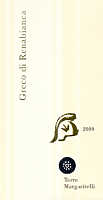
|
|
Greco di Renabianca 2009 |
|
| Terre Margaritelli (Umbria, Italy) | |
| Grapes: Grechetto | |
| Price: € 9.90 | Score: |
| Greco di Renabianca shows a brilliant straw yellow color and nuances of straw yellow, very transparent. The nose denotes intense, clean, pleasing and refined aromas that start with hints of apple, plum and hazelnut followed by aromas of hawthorn, broom, honey and vanilla. The mouth has good correspondence to the nose, a crisp attack and however balanced by alcohol, good body, intense flavors, pleasing roundness. The finish is persistent with flavors of apple, plum and hazelnut. Greco di Renabianca ages for 2 months in barrique, one month in steel tanks and at least 3 months in bottle. | |
| Food Match: Pasta and risotto with meat, Roasted white meat, Roasted fish, Mushroom soups | |

|
|
Malot 2008 |
|
| Terre Margaritelli (Umbria, Italy) | |
| Grapes: Cabernet Sauvignon, Merlot | |
| Price: € 9.90 | Score: |
| Malot shows an intense ruby red color and nuances of garnet red, little transparency. The nose denotes intense, clean, pleasing and refined aromas which start with hints of black cherry, plum and black currant followed by aromas of violet, vanilla, tobacco, peanut butter, chocolate and menthol. The mouth has good correspondence to the nose, a tannic attack and however balanced by alcohol, good body, intense flavors, pleasing roundness. The finish is persistent with flavors of black cherry, plum and black currant. Malot ages for 9 months in barrique followed by 3 months of aging in bottle. | |
| Food Match: Roasted meat, Broiled meat and barbecue, Stewed meat with mushrooms | |
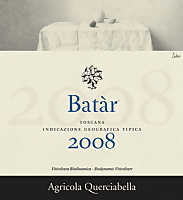
|
|
Batàr 2008 |
|
| Querciabella (Tuscany, Italy) | |
| Grapes: Pinot Blanc, Chardonnay | |
| Price: € 49.00 | Score: |
| Batàr shows a brilliant golden yellow color and nuances of golden yellow, very transparent. The nose reveals intense, clean, pleasing, refined and elegant aromas that start with hints of apple, banana and plum followed by aromas of honey, vanilla, praline, hawthorn, pear, hazelnut, grapefruit and graphite. The mouth has good correspondence to the nose, a crisp attack and however balanced by alcohol, full body, intense flavors, pleasing roundness. The finish is persistent with flavors of banana, grapefruit and hazelnut. Batàr ferments and ages in barrique for about 12 months. | |
| Food Match: Roasted fish, Stuffed pasta with mushrooms, Roasted white meat, Sauteed meat | |
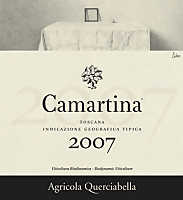
|
|
Camartina 2007 |
|
| Querciabella (Tuscany, Italy) | |
| Grapes: Cabernet Sauvignon (70%), Sangiovese (30%) | |
| Price: € 79.00 | Score: |
| Camartina shows an intense ruby red color and nuances of garnet red, little transparency. The nose reveals intense, clean, pleasing, refined and elegant aromas which start with hints of black cherry, black currant and violet followed by aromas of plum, blueberry, tobacco, vanilla, cocoa, cinnamon, mace, pink pepper, clover and eucalyptus. The mouth has excellent correspondence to the nose, a tannic attack and however balanced by alcohol, full body, intense flavors, agreeable. The finish is very persistent with long flavors of black cherry, black currant and plum. Camartina ages for 12 months in barrique. | |
| Food Match: Game, Roasted meat, Stewed and braised meat, Hard cheese | |
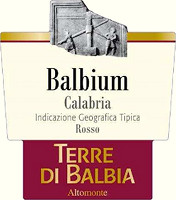
|
|
Balbium 2009 |
|
| Terre di Balbia (Calabria, Italy) | |
| Grapes: Magliocco Canino | |
| Price: € 14.00 | Score: |
| Balbium shows an intense ruby red color and nuances of ruby red, little transparency. The nose denotes intense, clean and pleasing aromas which start with hints of plum, blackberry and black cherry followed by aromas of blueberry, violet, vanilla and carob. The mouth has good correspondence to the nose, a slightly tannic attack and however balanced by alcohol, good body, intense flavors. The finish is persistent with flavors of plum, blackberry and black cherry. Balbium ages for 10 months in cask. | |
| Food Match: Pasta with meat, Broiled meat and barbecue, Stewed meat with mushrooms | |
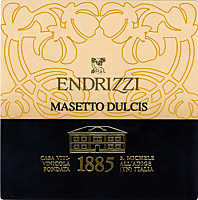
|
|
Masetto Dulcis 2008 |
|
| Endrizzi (Trentino, Italy) | |
| Grapes: Golden Muscat, Sauvignon Blanc, Riesling, Chardonnay, Gewürztraminer | |
| Price: € 27.85 - 375ml | Score: |
| Masetto Dulcis shows a deep golden yellow color and nuances of golden yellow, transparent. The nose denotes intense, clean, pleasing and refined aromas that start with hints of grape, honey and citrus fruits peel followed by aromas of dried apricot, oregano, quince jam, lavender, almond, dried fig, almond and nail polish. The mouth has good correspondence to the nose, a sweet and round attack, however balanced by alcohol, good body, intense flavors, pleasing crispness. The finish is persistent with flavors of grape, honey and dried apricot. Masetto Dulcis is produced with dried grapes and ferments in cask. | |
| Food Match: Confectionery, Hard and piquant cheese | |
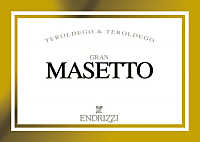
|
|
Gran Masetto 2007 |
|
| Endrizzi (Trentino, Italy) | |
| Grapes: Teroldego | |
| Price: € 47.50 | Score: |
| Gran Masetto shows a deep ruby red color and nuances of garnet red, little transparency. The nose reveals intense, clean, pleasing, refined and elegant aromas which start with hints of blackberry, plum and dried violet followed by aromas of black cherry, blueberry, cinnamon, vanilla, chocolate, mace, dried rose, pink pepper, tobacco and menthol. The mouth has good correspondence to the nose, a tannic attack and however balanced by alcohol, full body, intense flavors, pleasing roundness. The finish is very persistent with long flavors of blackberry, plum and black cherry. Gran Masetto ages for 20 months in barrique followed by 6 months of aging in bottle. | |
| Food Match: Game, Roasted meat, Braised meat, Hard cheese | |
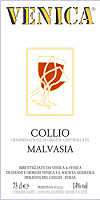
|
|
Collio Malvasia 2010 |
|
| Venica (Friuli Venezia Giulia, Italy) | |
| Grapes: Malvasia Istriana | |
| Price: € 16.00 | Score: |
| Collio Malvasia shows an intense straw yellow color and nuances of straw yellow, very transparent. The nose reveals intense, clean, pleasing and refined aromas which start with hints of apple, hazelnut and apricot followed by aromas of banana, citrus fruit, hawthorn, broom, pear and praline. The mouth has good correspondence to the nose, a crisp attack and however balanced by alcohol, good body, intense flavors, pleasing roundness. The finish is persistent with flavors of apple, apricot and hazelnut. A part of Collio Malvasia ages for 5 months in cask. | |
| Food Match: Pasta and risotto with fish, Sauteed fish, Broiled crustaceans | |
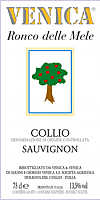
|
|
Collio Sauvignon Ronco delle Mele 2010 |
|
| Venica (Friuli Venezia Giulia, Italy) | |
| Grapes: Sauvignon Blanc | |
| Price: € 26.00 | Score: |
| Collio Sauvignon Ronco delle Mele shows an intense greenish yellow color and nuances of greenish yellow, very transparent. The nose reveals intense, clean, pleasing and refined aromas which start with hints of peach, elder and passion fruit followed by aromas of nettle, pear, grapefruit, bell pepper, hawthorn, apple and mineral. The mouth has good correspondence to the nose, a crisp attack and however balanced by alcohol, good body, intense flavors, pleasing roundness. The finish is persistent with flavors of peach, passion fruit and apple. A small part of Collio Sauvignon Ronco delle Mele ages in cask. | |
| Food Match: Broiled crustaceans, Pasta and risotto with fish and crustaceans, Crustacean soups | |
News |
|
In this section are published news and information about events concerning the world of wine and food. Whoever is interested in publishing this kind of information can send us a mail to our address.
|
AquavitaeReview of Grappa, Distillates and Brandy |
|
|
| Distillates are rated according to DiWineTaste's evaluation method. Please see score legend in the "Wines of the Month" section. |
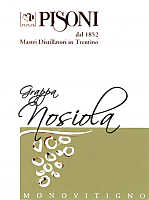
|
|
Grappa Nosiola |
|
| Pisoni (Trentino, Italy) | |
| Raw matter: Pomace of Nosiola | |
| Price: € 14.00 - 70cl | Score: |
| This grappa is colorless, limpid and crystalline. The nose reveals intense, clean, pleasing and refined aromas of pear, apple, broom, hawthorn, banana and hazelnut, with almost imperceptible alcohol pungency. In the mouth has intense flavors with perceptible alcohol pungency which tends to dissolve rapidly, balanced sweetness, pleasing roundness, good correspondence to the nose. The finish is persistent with flavors of pear, apple and hazelnut. This grappa is is distilled in a batch bainmarie alembic still. Alcohol 43%. | |
Wine Parade |
|
|
| The best 15 wines according to DiWineTaste's readers. To express your best three wines send us an E-mail or fill in the form available at our WEB site. |
| Rank | Wine, Producer | |
|---|---|---|
| 1 |
| Trento Brut Riserva Methius 2004, Dorigati (Italy) |
| 2 |
| Aglianico del Vulture Il Repertorio 2006, Cantine del Notaio (Italy) |
| 3 |
| Soave Motto Piane 2008, Fattori (Italy) |
| 4 |
| Arkezia Muffo di San Sisto 2004, Fazi Battaglia (Italy) |
| 5 |
| Brunello di Montalcino Progetto Prime Donne 2004, Donatella Cinelli Colombini (Italy) |
| 6 |
| Confini 2007, Lis Neris (Italy) |
| 7 |
| Barolo Bussia 2001, Prunotto (Italy) |
| 8 |
| Brunello di Montalcino Vigneto Manachiara 2005, Tenute Silvio Nardi (Italy) |
| 9 |
| Chianti Classico Riserva 2005, Capannelle (Italy) |
| 10 |
| Barolo Cannubi Boschis 2005, Sandrone (Italy) |
| 11 |
| Sangiovese di Romagna Superiore Riserva Thea 2005, Tre Monti (Italy) |
| 12 |
| Aglianico del Vulture La Firma 2004, Cantine del Notaio (Italy) |
| 13 |
| Rosso Conero Riserva Grosso Agontano 2007, Garofoli (Italy) |
| 14 |
| Sagrantino di Montefalco Passito 2004, Adanti (Italy) |
| 15 |
| Brunello di Montalcino 2006, Siro Pacenti (Italy) |
| |||||||
Privacy Policy | |||||||


| Copyright © 2002-2024 Antonello Biancalana, DiWineTaste - All rights reserved |
| All rights reserved under international copyright conventions. No part of this publication and of this WEB site may be
reproduced or utilized in any form or by any means, electronic or mechanical, without permission in writing from DiWineTaste. |